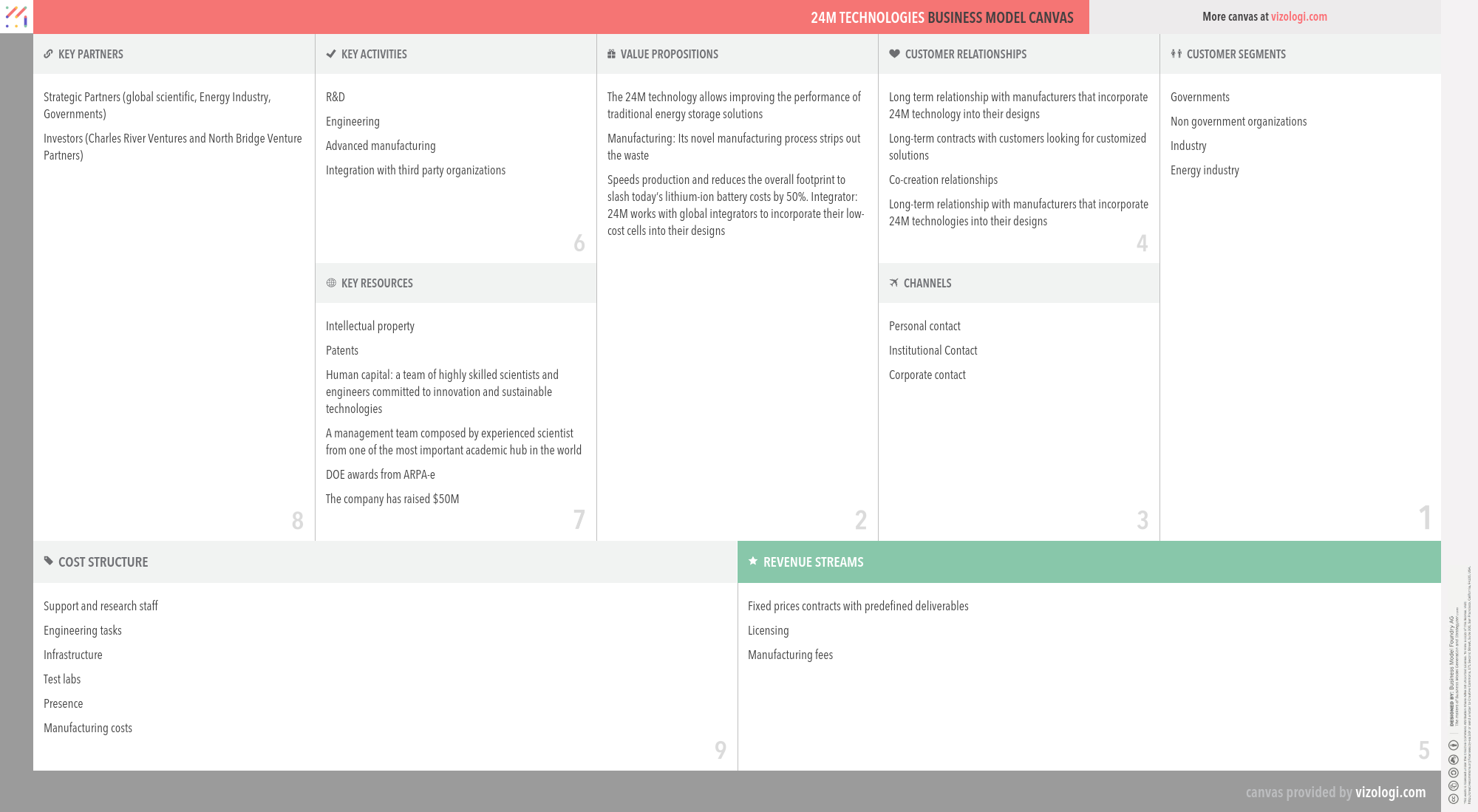Why 24M Technologies's Business Model is so successful?
Get all the answers 
24M Technologies’s Company Overview
24M solves the grand challenge of energy storage with the invention of the semisolid lithium-ion battery, a revolutionary technology for the architects of our energy future. By upending the design of the battery cell, as well as how the batteries are made, the company solves the critical, decades-old challenge associated with the world’s preferred form of energy storage: reducing its high cost while maintaining its strengths. Founded and led by some of the battery industry’s foremost inventors, scientists and entrepreneurs, 24M is headquartered in Cambridge, Massachusetts, just blocks away from MIT in the heart of a dynamic innovation ecosystem.
http://24-m.com/Country: Massachusetts
Foundations date: 2010
Type: Private
Sector: Technology
Categories: Energy
24M Technologies’s Customer Needs
Social impact:
Life changing: self-actualization
Emotional: attractiveness, provides access, design/aesthetics
Functional: simplifies, integrates, quality, organizes, reduces costs, reduces risks, reduces effort, reduces costs, avoids hassles, quality
24M Technologies’s Related Competitors
24M Technologies’s Business Operations
Aikido:
The aikido business model is often characterized as using a competitor's strength to get an edge over them. This is accomplished through finding weaknesses in a competitor's strategic position. In addition, it adds to marketing sustainability by exposing rivals' flaws, finding internal and external areas for development, and attracting consumers via specific product offers that deviate from the norm.
Corporate renaissance:
Improving management and performance for companies of all sizes, industries, and globally via creative solutions. Alternate Capital Raising Platform is a novel method of obtaining money that connects the prospective buyer with available capital sources such as venture capital funds, angel investors, and others.
Energy:
Energy development is an area of study concerned with adequate primary and secondary energy sources to satisfy society's requirements. These activities include those that promote the development of conventional, alternative, and renewable energy sources and the recovery and recycling of energy that otherwise would have been squandered.
Integrator:
A systems integrator is an individual or business specializing in integrating component subsystems into a unified whole and ensuring that those subsystems work correctly together. A process is known as system integration. Gains in efficiency, economies of scope, and less reliance on suppliers result in cost reductions and may improve the stability of value generation.
Layer player:
Companies that add value across many markets and sectors are referred to be layer players. Occasionally, specialist companies achieve dominance in a specific niche market. The effectiveness of their operations, along with their economies of size and footprint, establish the business as a market leader.
Licensing:
A formal agreement in which the owner of the copyright, know-how, patent, service mark, trademark, or other intellectual property grants a licensee the right to use, manufacture, and sell copies of the original. These agreements often restrict the licensee's scope or area of operation, define whether the license is exclusive or non-exclusive, and stipulate whether the licensee will pay royalties or another kind of compensation in return. While licensing agreements are often used to commercialize the technology, franchisees also utilize them to encourage the sale of products and services.
Performance-based contracting:
Performance-based contracting (PBC), sometimes referred to as performance-based logistics (PBL) or performance-based acquisition, is a method for achieving quantifiable supplier performance. A PBC strategy focuses on developing strategic performance measures and the direct correlation of contract payment to success against these criteria. Availability, dependability, maintainability, supportability, and total cost of ownership are all standard criteria. This is accomplished mainly via incentive-based, long-term contracts with precise and quantifiable operational performance targets set by the client and agreed upon by contractual parties.
Skunkworks project:
A skunkworks project is one that is created by a small, loosely organized group of individuals who study and develop a project with the primary goal of radical innovation. The terminology arose during World War II with Lockheed's Skunk Works project. However, since its inception with Skunk Works, the phrase has been used to refer to comparable high-priority research and development initiatives at other big companies that include a small team operating outside of their regular working environment and free of managerial restrictions. Typically, the phrase alludes to semi-secretive technological initiatives, such as Google X Lab.
Solution provider:
A solution provider consolidates all goods and services in a particular domain into a single point of contact. As a result, the client is supplied with a unique know-how to improve efficiency and performance. As a Solution Provider, a business may avoid revenue loss by broadening the scope of the service it offers, which adds value to the product. Additionally, close client interaction enables a better understanding of the customer's habits and requirements, enhancing goods and services.
Sustainability-focused:
Companies that manufacture fast-moving consumer goods and services and are committed to sustainability do ecological impact assessments on their products and services. While research-based green marketing needs facts, green storytelling requires imagination and location. Employees responsible for the brand definition and green marketers collaborate with product and service designers, environmental groups, and government agencies.
Recommended companies based on your search:

